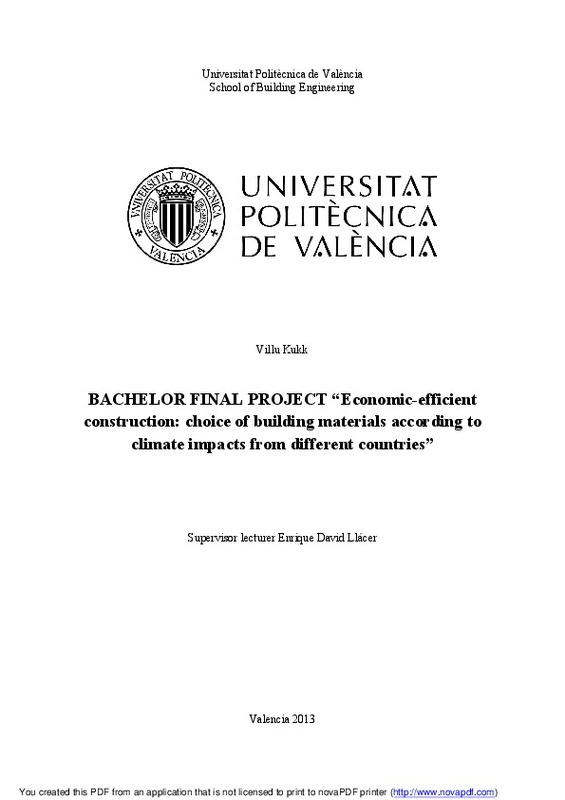JavaScript is disabled for your browser. Some features of this site may not work without it.
Buscar en RiuNet
Listar
Mi cuenta
Estadísticas
Ayuda RiuNet
Admin. UPV
Economic-efficient construction: choice of building materials according to climate impacts from different countries
Mostrar el registro sencillo del ítem
Ficheros en el ítem
| dc.contributor.advisor | David Llacer, Enrique
|
es_ES |
| dc.contributor.author | Kukk, Villu
|
es_ES |
| dc.date.accessioned | 2013-12-30T09:04:36Z | |
| dc.date.available | 2013-12-30T09:04:36Z | |
| dc.date.created | 2013-06-14 | |
| dc.date.issued | 2013-12-30 | |
| dc.identifier.uri | http://hdl.handle.net/10251/34684 | |
| dc.description.abstract | [ES] El objetivo de este proyecto es estudiar el comportamiento térmico de diferentes materiales de construcción en diferentes ambientes. Los entornos elegidos pertenecen a dos países: Estonia y España, muy diferentes en razón de su clima. Para simplificar el proceso, se han utilizado cuatro modelos con diferentes combinaciones de materiales, dos por país. El modelo 1 y 2 pertenecen a Estonia y el modelo 3 y 4 a España. Estos modelos se han dividido en dos grupos: con estructura de mampostería (modelos 1 y 3) y con estructura de trama (modelos 2 y 4). En la primera fase del proyecto se incluyen los cálculos de acuerdo con los métodos de cada país basados en la conductividad térmica y el riesgo de condensación en las estructuras de los modelos. La segunda fase de cálculos se hizo con el programa Calener_VYP. Todos los cálculos se han realizado con datos ambientales de España y los dos primeros modelos son analizados y comparados con modelos españoles. Según los resultados de los cálculos de este estudio, se puede afirmar que en ambos países Estonia y España los modelos más eficientes fueron los de estructura de mampostería (modelos 1 y 2). Estos modelos combinan el consumo de energía para las propiedades de aislamiento térmico de calefacción y refrigeración. Estas estructuras externas se pueden mejorar con el desarrollo de materiales de construcción de aislamiento térmico. La investigación de este proyecto se centra en los materiales de cambio de fase y en su capacidad potencial de modificar los cerramientos de los edificios de consumo energético eficiente. | es_ES |
| dc.description.abstract | [EN] The aim of this project is to study the thermal behavior of different building materials in different environments. The environments chosen pertain to two countries: Estonia and Spain, two very different countries in terms of their climate and that is the reason why they have been chosen for this study. To simplify the process, four different models with different combination of materials were used for this study, two models for each country. Model 1 and 2 belongs to Estonia and models 3 and 4 to Spain. Models were divided into two groups: models with masonry-structure: 1 and 3, and models with frame-structure: 2 and 4. The first phase of the project includes calculations that were made according to calculation methods in each country based on the thermal conductivity and the risk of condensation in the model structures. Second phase is based on calculations made with the program Calener_VYP. All calculations are made with Spanish environmental data and the first two models are analyzed and compared with models from Spain. The program analyses models of energy consumption for heating and cooling and compares them with its own model. Following the model calculation results, in both countries Estonia and Spain, the most energy-efficient structure are the masonry-structures models (models 1 and 2). These models combine energy consumption for heating and cooling and thermal insulation properties. These external structures can be improved by developing building materials with thermal insulation properties. This research was focused on phase change materials as its potential ability to modify the closures of the energy efficient buildings. | es_ES |
| dc.format.extent | 39 | es_ES |
| dc.language | Español | es_ES |
| dc.publisher | Universitat Politècnica de València | es_ES |
| dc.rights | Reconocimiento - No comercial - Sin obra derivada (by-nc-nd) | es_ES |
| dc.subject | Arquitectura y clima | es_ES |
| dc.subject | Materiales de construcción | es_ES |
| dc.subject | Eficiencia energética | es_ES |
| dc.subject | Aislamiento térmico | es_ES |
| dc.subject | Estructuras (Construcción) | es_ES |
| dc.subject | Albañilería | es_ES |
| dc.subject.classification | CONSTRUCCIONES ARQUITECTONICAS | es_ES |
| dc.subject.other | Grado en Ingeniería de Edificación-Grau en Enginyeria d'Edificació | es_ES |
| dc.title | Economic-efficient construction: choice of building materials according to climate impacts from different countries | es_ES |
| dc.type | Proyecto/Trabajo fin de carrera/grado | es_ES |
| dc.rights.accessRights | Abierto | es_ES |
| dc.contributor.affiliation | Universitat Politècnica de València. Escuela Técnica Superior de Gestión en la Edificación - Escola Tècnica Superior de Gestió en l'Edificació | es_ES |
| dc.description.bibliographicCitation | Kukk, V. (2013). Economic-efficient construction: choice of building materials according to climate impacts from different countries. http://hdl.handle.net/10251/34684. | es_ES |
| dc.description.accrualMethod | Archivo delegado | es_ES |
Este ítem aparece en la(s) siguiente(s) colección(ones)
-
ETSIE - Trabajos académicos [2383]
Escuela Técnica Superior de Ingenieria de Edificación






